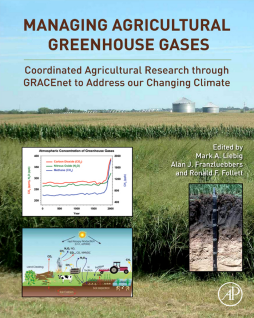
BOOK
Managing Agricultural Greenhouse Gases
Mark Liebig | A.J. Franzluebbers | Ronald F Follett
(2012)
Additional Information
Book Details
Abstract
Global climate change is a natural process that currently appears to be strongly influenced by human activities, which increase atmospheric concentrations of greenhouse gases (GHG). Agriculture contributes about 20% of the world’s global radiation forcing from carbon dioxide, methane and nitrous oxide, and produces 50% of the methane and 70% of the nitrous oxide of the human-induced emission. Managing Agricultural Greenhouse Gases synthesizes the wealth of information generated from the GRACEnet (Greenhouse gas Reduction through Agricultural Carbon Enhancement network) effort with contributors from a variety of backgrounds, and reports findings with important international applications.
- Frames responses to challenges associated with climate change within the geographical domain of the U.S., while providing a useful model for researchers in the many parts of the world that possess similar ecoregions
- Covers not only soil C dynamics but also nitrous oxide and methane flux, filling a void in the existing literature
- Educates scientists and technical service providers conducting greenhouse gas research, industry, and regulators in their agricultural research by addressing the issues of GHG emissions and ways to reduce these emissions
- Synthesizes the data from top experts in the world into clear recommendations and expectations for improvements in the agricultural management of global warming potential as an aggregate of GHG emissions
"...extremely well written and should be of interest to professionals as well as to advanced graduate students interested in agricultural GHG dynamics." --Journal of Environmental Quality
"Whichever discipline the reader may originate from, this book will provide a more holistic viewpoint of managing greenhouse gas emissions and carbon sequestration in agriculture. For researchers, industry professionals, and regulators, Liebig et al., who are associated with the US Department of Agriculture-Agricultural Research Service (USDA-ARS), synthesize research findings from about 30 ARS locations participating in the GRACEnet (Greenhouse gas Reduction through Agricultural Carbon Enhancement network) project. Contributed by USDA and other agricultural researchers mostly from the US, the 29 chapters describe the evaluation of agricultural carbon sequestration and greenhouse gas management, measurement, and modeling; economic and policy considerations for the short-term future; and long-term opportunities and the need for research collaborations. They discuss current trends in greenhouse gas emissions, agricultural contributions to those emissions, and risks associated with global climate change; background on the GRACEnet initiative; soil organic carbon dynamics for prevalent agroecosystmes in the US (cropland, rangeland, pasture, and biofeedstock production systems); the responses of carbon dioxide, methane, and nitrous oxide fluxes to management; five common ecosystem models for estimating SOC dynamics and greenhouse gas flux; key attributes of analytical methods used to estimate carbon change in soil and greenhouse gas flux; economic outcomes, incentive programs, and policy scenarios associated with reducing greenhouse gas emissions; and networks worldwide involved in climate change-related research." --Reference & Research Book News
